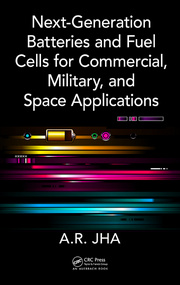Description
Next-Generation Batteries and Fuel Cells for Commercial, Military, and Space Applications
Author: Jha A.R.
Language: English
Subjects for Next-Generation Batteries and Fuel Cells for Commercial...:
Keywords
Energy Density; Al Air Batteries; Next-Generation Batteries; Ni MH Battery; Commercial Applications; Ni Cd Battery; Military Applications; Fuel Cells; Thermal Batteries; Li Ion Batteries; Battery Pack; EVs; Rare Earth Materials; TF Batterie; Ni MH Rechargeable Batterie; Power Consumption; Low Power Batteries; Ni Cd Rechargeable Batteries; Li Ion Rechargeable Batteries; Li Ion Battery Pack; Rechargeable Battery Packs; Pb Acid Batteries; Battery Power Requirements; Hybrid Electric; High Temperature Fuel Cells; Mission Duration; Porous Silicon; Embedded System Applications
406 p. · 15.6x23.4 cm · Hardback
Description
/li>Contents
/li>Readership
/li>Biography
/li>
Distilling complex theoretical physical concepts into an understandable technical framework, Next-Generation Batteries and Fuel Cells for Commercial, Military, and Space Applications describes primary and secondary (rechargeable) batteries for various commercial, military, spacecraft, and satellite applications for covert communications, surveillance, and reconnaissance missions. It emphasizes the cost, reliability, longevity, and safety of the next generation of high-capacity batteries for applications where high energy density, minimum weight and size, and reliability in harsh conditions are the principal performance requirements.
Presenting cutting-edge battery design techniques backed by mathematical expressions and derivations wherever possible, the book supplies an authoritative account of emerging application requirements for small, lightweight, high-reliability rechargeable batteries?particularly for portable and implantable medical devices and diagnostic capsules. It devotes a chapter to fuel cells and describes the three distinct types of practical fuel cells, including those that use aqueous electrolytes, molten electrolytes, and solid electrolytes.
- Identifies critical performance parameters and limits of rechargeable batteries, including state of charge, depth of discharge, cycle life, discharge rate, and open-circuit voltage
- Provides a foundation in the basic laws of electrochemical kinetics
- Highlights performance capabilities of long-life, low-cost, rechargeable batteries, for particular applications in battlefield systems and unmanned aerial vehicles (UAVs )
A.R. Jha, author of 10 books on alternative energy and other topics, outlines rechargeable battery requirements for electric vehicles (EVs), hybrid electric vehicles (HEVs), and plug-in hybrid electric vehicles (PHEVs). He identifies the unique materials for electrolytes, cathodes, and anodes that are most cost-effective with significant improvements in weight, size, efficiency, reliability, safety, and longevity. Since electrode kinetics play a key role in the efficient operation of fuel cells, the book also provides you with a foundation in the basic laws of electrochemical kinetics.
Current Status of Rechargeable Batteries and Fuel Cells. Batteries for Aerospace and Communications Satellites. Fuel Cell Technology. Batteries for Electric and Hybrid Vehicles. Low-Power Rechargeable Batteries for Commercial, Space, and Medical Applications. Rechargeable Batteries for Military Applications. Batteries and Fuel Cells for Aerospace and Satellite System Applications. Low-Power Batteries and Their Applications. Index.
A. R. Jha received his BS in engineering (electrical) from Aligarh Muslim University in 1954, his MS (electrical and mechanical) from Johns Hopkins University, and his PhD from Lehigh University.
Dr. Jha has authored 10 high-technology books and has published more than 75 technical papers. He has worked for companies such as General Electric, Raytheon, and Northrop Grumman and has extensive and comprehensive research, development, and design experience in the fi elds of radars, high-power lasers, electronic warfare systems, microwaves, and MM-wave antennas for various applications, nanotechnology-based sensors and devices, photonic devices, and other electronic components for commercial, military, and space applications. Dr. Jha holds a patent for MM-wave antennas in satellite communications.



